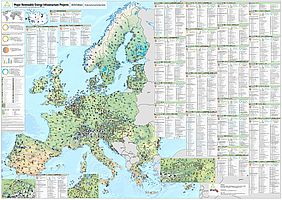The European Power Sector Report is an annual review of the status of energy transition in the electricity sector in Europe. For the fifth year in a row the German think-tank Agora Energiewende, dedicated to developing factual and politically viable strategies for a clean energy transition in Germany, Europe and the rest of the world, and Ember, a British independent climate think-tank focused on the global transition from coal to clean energy, have joined forces to provide an analysis of the electricity sector in Europe. The report looks at the full-year electricity generation of every EU country.
For 2000 to 2018, the data for the report was taken from EUROSTAT. The 2019 and 2020 data are an estimate of what the Eurostat data might be when published. For this purpose, the data were evaluated according to the year-on-year changes for each year; this was then added onto the 2018 Eurostat figures. To evaluate these changes, Ember’s monthly curated data for Europe from ENTSO-E was used and cross-checked against any available monthly data from Eurostat, as well as data from national TSOs. The authors, however, note that the biggest issue with Entso-E data is the classification of fossil generation in NL and IT, as well as poor coverage of small gas and bioenergy plants across most countries. For Germany, AG-Energiebilanzen was used for all years. Key topics addressed in this report comprise growth of renewables, conventional power generation, electricity consumption, and CO₂ emissions. For the 2020 report, please visit the homepage of Agora Energiewende.
2020 can rightfully be named Europe’s greenest electricity year, as for the first time more electricity was generated from renewables than from fossil fuels. Renewables amounted to 38 percent of electricity generation in 2020, compared to 37% for fossil fuels. This was mainly facilitated by a large increase in wind and solar power, which has almost doubled since 2015. The highest shares of renewables were witnessed in Denmark (61%), Ireland (35%), Germany (33%), and Spain (29%). The Netherlands, meanwhile, saw the largest rise in wind and solar generation in 2020 (40%).
Exactly the opposite can be said of coal-fired power generation, which has halved since 2015. In 2020, only 13% of Europe’s electricity was generated by coal. In contrast, electricity generation from natural gas decreased by only 4%. This was mainly due to the significant rise in the price of emission certificates, which enabled cheaper electricity production through more climate-friendly gas-fired power plants. In Germany, Poland, and the Czech Republic, gas undercut lignite-fired power generation for the first time in some months.
In total, electricity demand in Europe decreased by four percent in 2020, especially in April during the first wave of Covid-19.The most severe reductions in April were witnessed in Italy (-21%), France (-19%) and Spain (-17%). However, all three countries recorded higher year-on-year demand in December, which might point to a bounce-back to normal demand levels from 2021. At the same time, the pandemic does not seem to have severely impacted the growth of renewables, which was robust. Declines in fossil fuels were somewhat mitigated by an increased electricity demand later in the year and below-average nuclear generation.
Another result of the study was that CO2 emissions were reduced by 29 percent in 2020, with the carbon intensity of European electricity generation reaching a record low of 226 grams of CO2 per kilowatt-hour.
Despite the healthy development of renewable energy in Europe, wind and solar generation growth must almost triple to live up to Europe’s 2030 green deal targets: from 38 TWh per year average growth in 2010-2020 to 100 TWh per year average growth between 2020-2030. For now, national energy and climate plans have only achieved the production of about 72 TWh new wind and solar per year, not the 100 TWh/year which are required.
